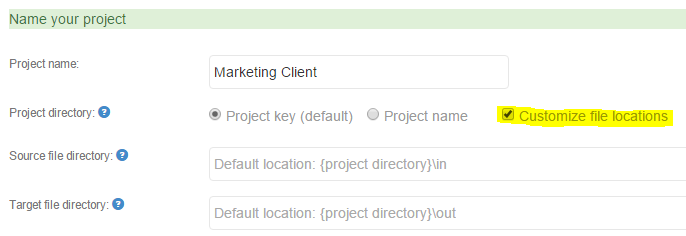Q&A - Translating Dropbox, Box, OneDrive, Google Drive and others
You can have the Beebox receive source files directly from any cloud sharing system and send back finished translations:
- Dropbox
- Box.com
- Google Drive
- Microsoft OneDrive
- Copy.com
- FTP
- Any other
Your customers can then exchange files with you using your preferred cloud sharing solution. Beebox kicks-off workflows in a semi or automated manner and can even send out confirmation emails to your customers. Best of all: This is a native feature of Beebox and easy to setup.
Getting started
These are the simple steps:
- Prerequisite: Install your cloud sharing software on the same server you are running Beebox. The cloud files are then synchronized and accessible by your Beebox. For example, the copy.com sharing solution, by default, synchronizes files to C:\Users\Administrator\Copy (if it was installed by the administrator).
- Create a new Beebox project. This can be either a regular project or a pass-through project.
- In the project creation wizard, tick the Customize file locations option:

- Fill in the cloud sharing directories. These are the locations you exchange files with your client in the cloud.

Make sure that the two directories exist or create them now.
Complete your project configuration, translation workflows as described in other sections of this online guide.
Finally, share the locations specified above with your customer. How this is done depends on the specific cloud sharing solution used.
How does the customer tell me from and into which languages to translate?
How does it work by default? All files sent to the cloud by the customers are picked up in the Beebox project. Translation is done into all target languages you have configured in the project.
If the customer wants to decide on target languages on a case by case basis, you would proceed like this:
- Create a Beebox project for English to Spanish. Link to cloud directories such as "c:\Users\Administrator\Copy\Client\EnglishToSpanish\In".
- Create a Beebox project for English to Chinese. Link to cloud directories such as "c:\Users\Administrator\Copy\Client\EnglishToChinese\In".
- ...
That is you would create one separate Beebox project per language combination or type of content.
Advanced integration scenarios
If the files are not deposited in the cloud by a human but rather a software system, you can have the software system include "instructions" with each file to translate. The instructions can specify:
- The target language or languages (so a single Beebox project would be sufficient)
- A deadline
- Comments or other meta information
The instructions are stored are JSON formatted. Let us suppose the source file is document-200.xml. In that case the instructions file must be named document-200.xml.beebox . The software would append “.beebox” to the original file name like in the example below:
The instructions file format and naming conventions are discussed in the API documentation (though you would not use the API).
